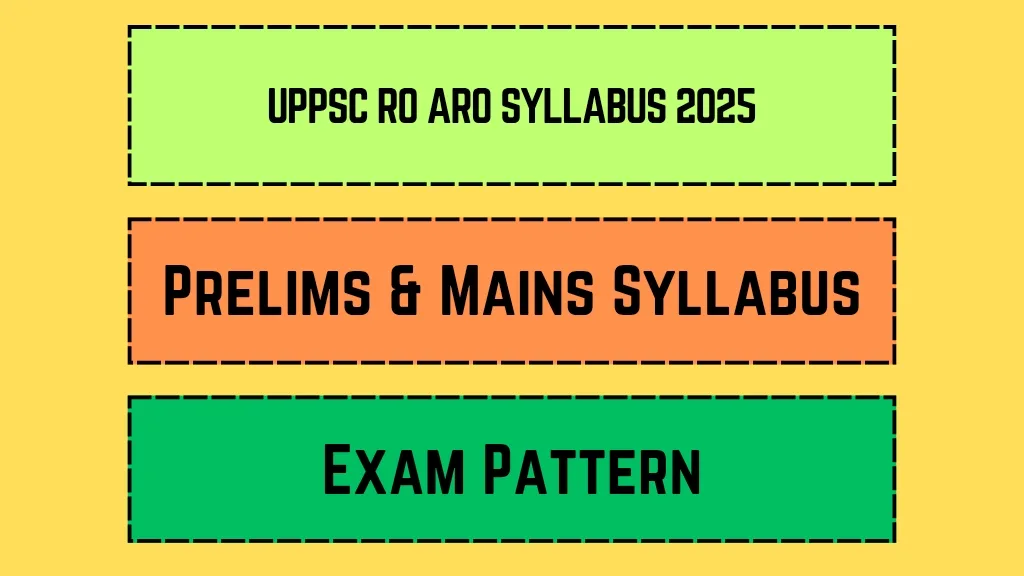The UPPSC RO ARO Syllabus 2025 is your roadmap to cracking one of Uttar Pradesh’s most competitive exams. Whether you’re aiming for Review Officer (RO) or Assistant Review Officer (ARO), understanding the syllabus and exam pattern is half the battle won. The exam has three stages—Prelims, Mains, and Typing Test—each with its own challenges.
With 411 vacancies up for grabs, competition is fierce. But don’t worry—this guide breaks down everything you need to know, from marking schemes to high-weightage topics. Let’s dive in!
Key Highlights of UPPSC RO ARO 2025 📌
| Key Point | Details |
|---|---|
| Organization Name | Uttar Pradesh Public Service Commission (UPPSC) |
| Posts | Review Officer (RO) & Assistant Review Officer (ARO) |
| Vacancies | 411 |
| Exam Stages | Prelims → Mains → Typing Test |
| Prelims Marks | 200 (140 for GS, 60 for Hindi) |
| Mains Marks | 400 (120 GS, 160 Hindi + Drafting, 120 Essay) |
| Negative Marking | 0.33 marks per wrong answer |
| Exam Mode | Online (Prelims), Offline (Mains) |
| Official Website | uppsc.up.nic.in |
UPPSC RO ARO Exam Pattern 2025 📝
Prelims Exam Structure
The first hurdle is the Prelims, which screens candidates for the Mains. Here’s how it’s structured:
| Paper | Subject | Questions | Marks | Duration |
|---|---|---|---|---|
| Paper 1 | General Studies | 140 | 140 | 120 mins |
| Paper 2 | General Hindi | 60 | 60 | 60 mins |
| Total | – | 200 | 200 | 180 mins |
🔹 Key Notes:
- Objective-type MCQs
- 1 mark per correct answer
- Negative marking (0.33 per wrong attempt)
Mains Exam Structure
If you clear Prelims, the Mains is next—a more detailed and descriptive test.
| Paper | Subject | Marks | Duration |
|---|---|---|---|
| Paper 1 | General Studies | 120 | 120 mins |
| Paper 2 | General Hindi & Drafting (Part 1: Conventional) | 100 | 150 mins |
| Paper 2 | General Vocabulary (Part 2: Objective) | 60 | 30 mins |
| Paper 3 | Hindi Essay | 120 | 180 mins |
| Total | – | 400 | 480 mins |
🔹 Key Notes:
- Conventional + Objective mix
- Hindi Essay has 3 topics (40 marks each)
UPPSC RO ARO Syllabus 2025 (Prelims) 📚
Paper 1: General Studies
This paper tests your general awareness and knowledge of UP-specific topics.
| Topic | Key Areas |
|---|---|
| History of India | Ancient, Medieval, Modern (Freedom Struggle) |
| Indian Polity & Economy | Constitution, Fundamental Rights, Economic Policies |
| Geography | Physical & World Geography, Natural Resources |
| Current Affairs | National & International Events |
| Science & Tech | Basic Physics, Chemistry, Biology |
| UP Special Knowledge | Culture, Agriculture, Social Traditions |
Paper 2: General Hindi
This is scoring if you’re strong in Hindi basics.
| Topic | Marks Weightage |
|---|---|
| Antonyms (विलोम) | 10 |
| One-word Substitution | 10 |
| Sentence Correction | 10 |
| Synonyms (पर्यायवाची) | 10 |
| Adjectives (विशेषण) | 10 |
🔹 Pro Tip: Focus on vocabulary and grammar rules—they’re easy marks!
UPPSC RO ARO Syllabus 2025 (Mains) 📖
Paper 1: General Studies
Same as Prelims but more in-depth. Expect analytical questions on:
- Indian National Movement
- UP’s Economy & Agriculture
- Environmental Issues
Paper 2: General Hindi & Drafting
This is where administrative skills are tested.
| Section | Key Tasks | Marks |
|---|---|---|
| Precis Writing | Summarize govt. letters | 21 |
| Official Letters | Draft memos, circulars | 24 |
| Translation | English ↔ Hindi | 10 |
| Idioms & Phrases | Explain common sayings | 5 |
Paper 3: Hindi Essay
You’ll write 3 essays (600 words each) on:
- Literature, Culture, or Politics
- Science, Economy, or Agriculture
- National/International Events
🔹 Expert Insight:
“Practice essay structuring—introduction, arguments, conclusion. Examiners look for clarity and flow.”
Final Tips to Ace UPPSC RO ARO 2025 🚀
- Prioritize High-Weightage Topics – Focus on GS & Hindi Grammar first.
- Mock Tests & PYQs – Solve past papers to understand patterns.
- Time Management – Prelims is speed-based; Mains needs depth.
- Typing Practice – The final stage requires 30 WPM in Hindi.
🔹 Real-Life Example:
Last year’s topper, Riya Sharma, credited her success to daily essay practice and revising UP-specific GK twice a week.
Now that you’ve got the full breakdown, it’s time to start studying smart. Good luck! 🎯

